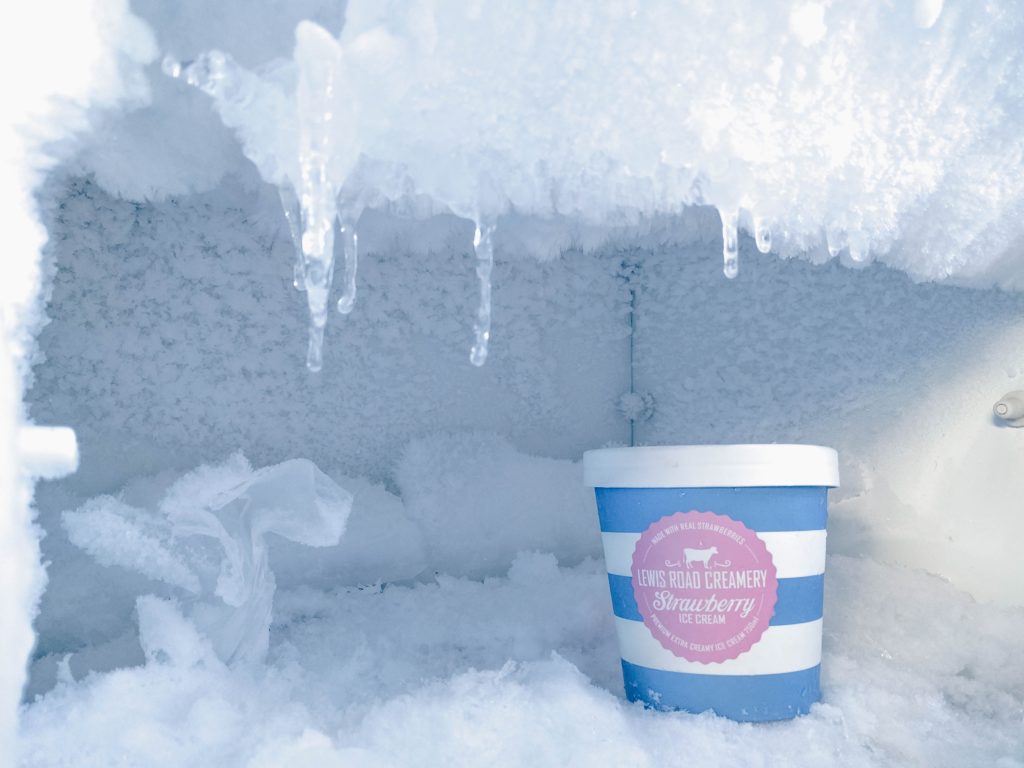All fields are required
Posted in Food Safety on August 14, 2018

“I scream, You scream, we all scream for ice cream!” These are the words that bring a smile to your face and perhaps a brain freeze to the noggin. Turns out even safe ice cream can have dire consequences if not handled properly.
It’s something we probably have all done at one point or another. You pull out the ice cream. Put some hearty scoops in the bowl. Walk away and enjoy your delicious treat. You look down at your unfinished bowl and think, “I’ll finish this later. I don’t want it to go to waste.” You return to the counter. See your ice cream melting in the container. Pop both the bowl and the container of ice cream back in the freezer. In the next day or so you go back for seconds and enjoy what was left behind. If you have done some or all of these things, you could have put yourself at risk of foodborne illness. Even from perfectly safe ice cream.
Don’t take my word for it. The famed Ben and Jerry’s even have a motto, “if it’s melted it’s ruined.” But what exactly does that mean?
Why the Texture Change?
Ice cream is an emulsion of fats, oils, sugars, and air blended in a specific way to form the creamy texture you know ice cream to be. When ice cream melts, the fats and oils separate in the solution. Things float here and there. The air whipped into the dairy treat will fall flat.
Refreezing puts those molecules in place where ever they may land. This often makes for a more crystalline or gritty texture when you attempt to consume the re-frozen treat. The lost air is responsible for making that dense block of frozen ice you will find the next time you peel back that lid or dig in to that bowl.
Even if you can move passed the texture and enjoy the sugary treat for what it is. You probably shouldn’t.
Melted Ice Cream Breeds Bacteria
According to Amreen Bashir, a lecturer of biomedical sciences at the Aston University in Birmingham, England, when ice cream “is taken from the freezer, left out to thaw and then returned to the freezer before being taken out and to eat again later,” she says it acts as a petri dish for bacteria, such as Listeria monocytogenes to grow and breed.
According to Bashir, “Ice cream melts fairly rapidly at room temperature and the milky, sugary, liquid concoction is a perfect petri dish for bacteria like listeria, essentially the second time you dig into the tub.” Ice cream melts even just outside of freezing temperature at about 31 ⁰F (-0.5 ⁰C).
When ice cream is made frozen and from pure ingredients, the likelihood of pathogenic bacteria consumed is quite small. There may be miniscule amounts present, but no where near harmful levels. Giving that tiny bit of harmful bacteria (along with anything in the air or that could have fallen into the container or bowl) the means to reproduce is where the problem unfolds.
Double dippers risk even more. Never go into a container of ice cream with a dirty spoon. You also do not want to eat from the large container unless you can finish it in one setting. This isn’t an eating contest, so be honest with yourself. Double dipping (while gross on its own) introduces additional risk. Adding your own bacteria to this germ food allows other bugs to flourish and grow as well. What you end up with is a cocktail of sugar and pathogenic levels of bacteria in your oddly textured dairy treat.
What Kinds of Illness Are We Talking About?
How bad can it be? Well, as a foodborne illness survivor I can tell you that it is not an experience you willingly want to endure. Most bacteria that will propagate in melted ice cream such as Listeria monocytogenes and Salmonella offer a plethora of gastrointestinal symptoms from vomiting and diarrhea to more serious complication such as still birth and death.
Moral of the Story
The moral of the story is that re-freezing ice cream puts you and your family at risk for foodborne illness. Double dipping into ice cream and re-freezing amplifies that risk. Not only is the taste and texture compromised, you risk serious and sometimes life-threatening infection when you consume it. According to Ben and Jerry’s, a perfect temperature for ice cream is between 10 ⁰F and 14 ⁰F. Not below, and certainly not above.
Consider making your own homemade ice cream instead.
Skip Commercial and Make Your Own Small Batch Ice Cream
Making your own homemade ice cream can be a rewarding experience and a fun activity for the kids. A few safety tips can help keep this a safe experience for you and your family as well.
Avoid homemade recipes that call for eggs, as this can introduce additional unnecessary risk of Salmonella and other germs hitching a ride on the raw egg. Be sure to use only pasteurized milk or cream and clean containers when making your homemade treat. Since a small batch works up rather quickly, only make what you intend to eat. This way there is no worries about re-freezing the left overs.
Below you will find an easy recipe that makes a single serving in about 20 minutes. It’s a great activity the whole family can enjoy. In no time you can enjoy your own homemade ice cream!
Yield – 1 serving
Prep Time – 5 minutes
Cooking Time – 15 minutes
Ingredients:
Directions:
Recipe above is for homemade vanilla ice cream. Play with add-ins like strawberries, chocolate chips, or cookies. See what new recipes you can come up with.
By: Heather Van Tassell, Contributing Writer (Non-Lawyer)